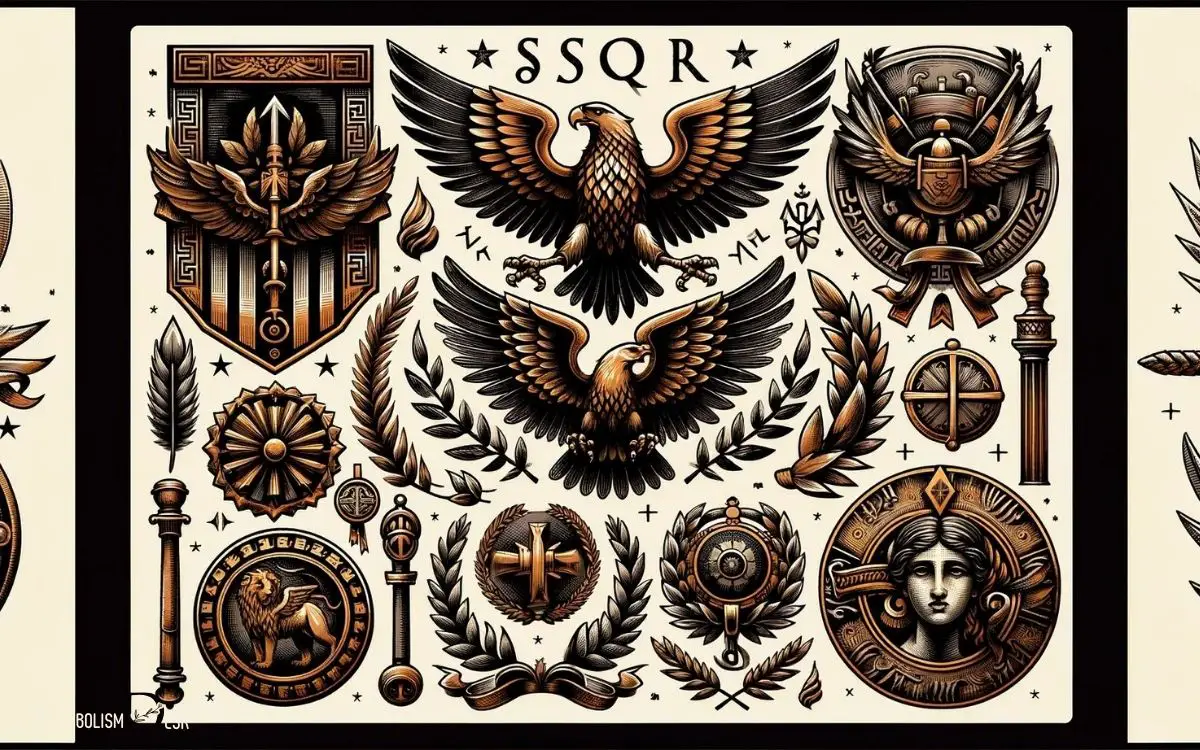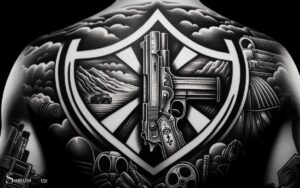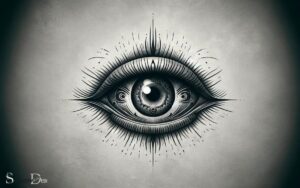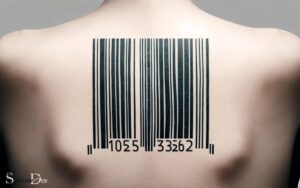Roman Symbol Tattoos With Meaning: Explanation!
Roman symbol tattoos are popular for their historical and cultural significance. Common symbols include SPQR for citizenship, the eagle for power, Roman numerals for dates, and laurel wreaths for victory.
These tattoos pay homage to Roman heritage and personal milestones, offering a lasting connection to the past.

Key Takeaway
The Power of the Eagle Symbol
The eagle holds significant symbolism in Roman culture. It represents strength, power, and leadership.
In Roman mythology, Jupiter, the king of gods, was often depicted with an eagle by his side. This emphasized the bird’s association with authority and divinity.
This powerful symbolism has transcended time and is now a popular choice for Roman symbol tattoos.
The eagle in these tattoos often represents the qualities of courage, vision, and immortality. It serves as a reminder of the enduring legacy of the Roman Empire and the virtues it upheld.
Individuals who choose to ink themselves with the eagle symbol aim to embody these traits and honor the rich history and cultural heritage it represents. The eagle symbol in Roman tattoos is a testament to the enduring allure of ancient Roman ideals.
Exploring Roman Numerals in Tattoos
Individuals often opt for Roman numeral tattoos to commemorate significant dates or meaningful numbers in their lives.
Roman numeral tattoos can be a unique and stylish way to represent important dates or numbers.
Here are a few reasons why people choose to incorporate Roman numerals into their tattoos:
- Timelessness: Roman numerals have a classic and timeless aesthetic, making them a popular choice for tattoos.
- Personal Significance: The numbers represented in Roman numerals often hold personal significance, such as a birthdate, anniversary, or lucky number.
- Simplistic Elegance: The sleek and minimalistic design of Roman numerals appeals to those who prefer a more understated tattoo.
Now, let’s delve into the symbolism of strength and courage with the Roman helmet.
Strength and Courage: The Roman Helmet
Wearing a Roman helmet tattoo symbolizes strength and courage, embodying the valor and bravery associated with ancient Roman warriors.
The helmet, known as the galea, was an essential part of the Roman soldier’s armor, providing protection in battle.
This symbol represents the resilience and fearlessness required in the face of adversity. The intricate design of the helmet often includes feathers or other decorative elements, adding to its visual appeal and significance.
For those seeking a tattoo that embodies fortitude and bravery, the Roman helmet is a powerful choice.
It serves as a reminder of the inner strength and determination needed to overcome challenges, making it a meaningful symbol for individuals who value courage and resilience in their lives.
Unveiling the Myth of Roman Gods and Goddesses
The symbolism of Roman gods and goddesses is deeply ingrained in ancient Roman culture, and their influence continues to resonate in modern society.
Understanding the mythological significance of these deities provides insight into the values and beliefs of the ancient Romans.
From Mars, the god of war, to Venus, the goddess of love, these iconic figures have left an indelible mark on art, literature, and even tattoo designs.
Symbolic Representations of Deities
Roman symbol tattoos often depict the Roman gods and goddesses with great significance and meaning. The deities represented in these tattoos hold various symbolic meanings that reflect the values and beliefs of ancient Roman culture. These tattoos can serve as powerful reminders of strength, wisdom, love, or justice, depending on the deity chosen. Additionally, many people incorporate Latin phrases or numerals alongside these designs, drawing from rich cultural traditions for personal expression. Such Latin symbols tattoo inspirations blend historical depth with modern artistry, offering a unique way to honor ancient Roman heritage.
Some of the most popular deities and their symbolic representations include:
- Jupiter: Often depicted with a lightning bolt, representing his role as the king of the gods and the god of thunder and lightning.
- Venus: Symbolized by the image of a rose, reflecting her association with love, beauty, and fertility.
- Mars: Represented by the spear and shield, symbolizing the god of war and agriculture.
These symbols not only serve as decorative elements but also carry deep cultural and historical significance, making them popular choices for those seeking to honor Roman mythology through body art.
Influence on Modern Culture
In contemporary society, the enduring influence of Roman gods and goddesses is evident through their incorporation into various aspects of popular culture.
From literature and art to movies and video games, the mythological figures of ancient Rome continue to captivate modern audiences.
Characters inspired by Roman deities frequently appear in contemporary fiction, often serving as symbols of power, wisdom, or love.
For instance, the character of Venus, the Roman goddess of love, has been reimagined in numerous romance novels and films.
Additionally, video games often feature characters with names and attributes drawn from Roman mythology, adding a layer of depth and meaning to the gaming experience.
This enduring influence highlights the timeless allure of Roman gods and goddesses, showcasing their ongoing relevance in today’s cultural landscape.
Roman Laurel Wreath: Symbol of Victory
The laurel wreath symbolizes victory and was worn by ancient Roman leaders. Its significance extends beyond its use as a decorative accessory, making it a popular motif in Roman art and culture.
Here’s why the laurel wreath is a powerful symbol:
- Victory: It represents triumph and success, often awarded to victorious athletes and military commanders.
- Honour: Wearing a laurel wreath signified a high level of achievement and was a mark of distinction.
- Eternal Glory: In Roman mythology, the laurel tree was sacred to Apollo, the god of prophecy and poetry, and was associated with immortality.
This enduring symbol of victory continues to inspire and hold meaning in contemporary society, serving as a reminder of the resilience and determination that leads to triumph.
This theme of victory is also reflected in the timeless beauty of Roman architecture.
The Timeless Beauty of Roman Architecture
Roman architecture stands as an enduring legacy, with its influence evident in modern design and urban planning.
The engineering marvels of antiquity, such as the Colosseum and the Pantheon, continue to inspire awe and admiration.
The timelessness of Roman architecture lies in its ability to blend functionality with aesthetic beauty, creating structures that transcend time and cultural boundaries.
Enduring Architectural Legacy
The enduring architectural legacy of ancient Rome continues to captivate and inspire with its timeless beauty and grandeur. Roman architecture has left an indelible mark on the world, showcasing the engineering prowess and artistic flair of the ancient Romans.
Key aspects of this enduring legacy include:
- Innovative Engineering: Roman architects were pioneers in designing structures that weren’t only aesthetically pleasing but also structurally sound, employing techniques such as the arch, vault, and dome.
- Iconic Structures: The Colosseum, Pantheon, and aqueducts stand as enduring testaments to Roman architectural prowess, showcasing the grandeur and scale of their constructions.
- Influence on Modern Architecture: The principles and designs of Roman architecture continue to influence and inspire architects and designers worldwide, highlighting the enduring impact of this ancient legacy.
Influence on Modern Design
With its timeless beauty and grandeur, Roman architecture’s enduring legacy continues to influence modern design, captivating and inspiring designers worldwide.
The majestic arches, intricate mosaics, and imposing columns of ancient Roman structures have left an indelible mark on contemporary architecture, interior design, and even fashion.
The clean lines and balanced proportions of Roman buildings are echoed in modern skyscrapers and urban landscapes, while the opulent details and decorative elements find their way into interior design and fashion collections.
The enduring appeal of Roman architecture lies in its ability to blend functionality with artistic expression, creating spaces that are both utilitarian and visually stunning.
This influence is a testament to the timelessness and universality of Roman design principles, which continue to shape and enrich the modern world.
Engineering Marvels of Antiquity
During antiquity, Roman architecture showcased unparalleled engineering marvels that continue to inspire awe and admiration in the modern era. The timeless beauty of Roman architecture is evidenced by its enduring impact on modern-day structures and urban planning.
Some of the most remarkable engineering marvels of Roman architecture include:
- The Colosseum: A monumental amphitheater known for its advanced construction techniques and innovative use of arches and vaults.
- The Pantheon: An architectural masterpiece featuring a pioneering dome design that remains a symbol of architectural ingenuity.
- Aqueducts: Complex systems of water supply that utilized gravity to transport water over long distances, showcasing the Romans’ expertise in hydraulic engineering.
These engineering feats not only reflect the technological prowess of ancient Rome but also serve as a testament to the enduring legacy of Roman architectural innovation.
These standards were essential to the identity of Roman soldiers and are still valued as powerful symbols in modern tattoo art.
Conclusion
Roman symbol tattoos carry a rich history and deep meanings that continue to inspire people today.
From the power of the eagle symbol to the strength and courage represented by the Roman helmet, these tattoos are a powerful way to connect with the ancient world.
Whether it’s the timeless beauty of Roman architecture or the significance of military standards, these symbols offer a unique and meaningful way to express oneself through body art.






